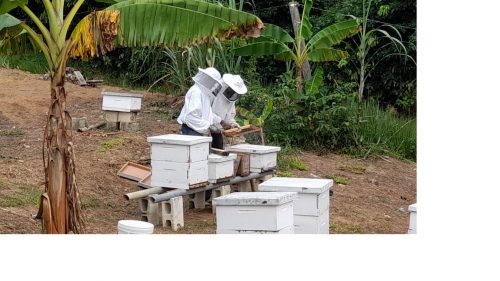Swift River Happy Bee Production in Portland is a micro community enterprise with big plans.
Over the next five years, the business, operated by the Swift River Community Development Committee (CDC) is looking to increase production from 10 gallons of honey per quarter to 200 gallons and also employ more people.
“We want to create jobs for others so that they can have cash flow to help the social and economic situation in the community,” Project Manager, Donna Burnett, tells JIS News.
Swift River Happy Bee Production also has plans to increase its offerings into other products such as honeycomb, lipstick, honey-sweetened juices, and shampoo while positively impacting the community.
The three-year-old honey business evolved out of a community group that was formed to enhance community life and increase togetherness through social and economic activities.
The group then decided to approach the SDC for assistance.
“They came [to our meeting] and were impressed to see how well we were working on our own and decided to take us up under the umbrella of the SDC,”Ms. Burnett says.
From there, the group became involved in activities such as community beautification, Labour Day projects and SDC-organised business fairs and grew to the level of a CDC under the hierarchy of the local governance framework.
The CDC decided to go a step further in providing an avenue for residents of the small Portland community to earn an income.
With an apiary donated by the United States Agency for International Development (USAID) under the Swift River Watershed project, the CDC embarked on the honey-production business, which, at its genesis in 2017, engaged up to 29 people.
“USAID had trained us to take care of the bees,” says Ms. Burnett, who is also President of the CDC.
“We have a beekeeper from the College of Agriculture, Science and Education (CASE) in Port Antonio, who would also come and teach us how. Before they came on stream with us, we, as a group, asked the Rural Agricultural Development Authority (RADA) to facilitate us by giving us pretraining,” she notes.

Residents were enthusiastic about the venture and generously volunteered their time and effort to get it off the ground.
Through the SDC Local Economic Development Support Programme, the CDC was able to access technical support and grant funding in February of this year to grow the business, which, by then, had five persons regularly employed.
“We recently received a grant of $100,000 and since then we have been able to move up to six persons. It was used towards business expansion, and as a result, we were able to build our capacity by purchasing well-needed gear to assist with the production and harvesting of the honey,” Ms. Burnett notes.
She says that the CDC also received assistance through the SDC in the form of direct support to complete the business model, business plan, and undertake capacity-building training in marketing and financial management.
“This allowed us to refine our processes to eliminate waste and unnecessary steps in the business process,” she notes further.
Ms. Burnett tells JIS News that through the SDC, the community enterprise was also able to increase the number of bee boxes by eight to now have a total of 23 boxes, enabling the entity to double honey production to10 gallons per quarter.
The business was also able to add another bottle size for its honey, which now comes in 500m and 750ml.
Ms. Burnett commends the support of the SDC in the growth of the CDC and the honey venture.
“The SDC has been so good to us. They have been an engine for us to grow our business where the community can benefit. The SDC has helped us navigate the business,” she shares.
For her part, Director of Local Economic Development and Community Projects at the SDC, Avril Ranger, commends the Swift River CDC and encourages other community groups to create viable initiatives for the benefit of residents.
“This is an example of how people can come together in groups to create viable enterprises that will generate employment. We want to encourage more CDCs to identify assets that can be transformed into viable enterprises. The SDC stands ready to support the development of community enterprises,” adds Ms. Ranger.

